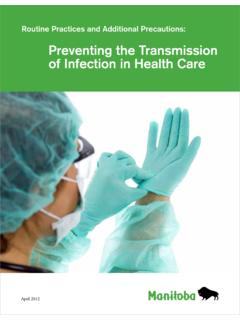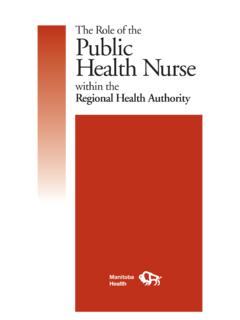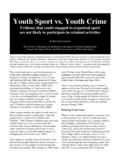Transcription of Best Practices in School-based Suicide Prevention: …
1 Best Practices in School-based Suicide Prevention: A Comprehensive Approach20142 Table of contents:The role of the school in youth Suicide prevention .. 3 Purpose of this guide.. 4 Context.. 5 Manitoba youth demographics ..5 Mental health and youth.. 6 Youth Suicide statistics ..9 Planning and programming for youth Suicide prevention in schools ..10A. Creating a comprehensive approach ..11 1. Policies and protocols ..11 2. school culture and climate ..12 3. Gatekeeper training..13 4. Education and awareness programs ..14 5. Targeting higher risk youth ..16 6. Peer support/student involvement..17 7. Family partnerships involving parents/caregivers ..18 8. Community links ..19B. Issues of importance to youth Suicide prevention efforts..21 Non-suicidal self injury (NSSI) ..21 Bullying ..22 Suicide contagion..23 Substance abuse ..24 Cultural safety..25 Monitoring and evaluation ..26C. Postvention..28 Appendices ..30 Links to resources..49 Youth crisis services in Manitoba..49 References.
2 503 The role of the school in Suicide preventionPreventing youth Suicide is an issue that naturally garners support from everyone including parents, policy makers and youth directly and indirectly affected. Schools can play a positive role in Suicide prevention because they offer consistent, direct contact time with large populations of young people. There are other important reasons why schools should be involved in Suicide Prevention: 1. Maintaining safe and caring school environments is an essential part of schools overall mission. All school staff have a role in creating school environments where students feel safe and cared for by adults around them. Promoting positive mental health and Suicide prevention efforts are consistent with other efforts and activities aimed at promoting student safety and creating caring environments. Many programs and activities designed to prevent violence, bullying, and substance abuse also reduce Suicide risk and promote healthy, caring relationships and resilience.
3 2. Students mental health can affect their academic performance. Mental health problems can interfere with the ability to learn and can affect academic performance. According to the 2009 Youth Risk Behavior Survey1: Approximately 1 of 2 high school students receiving grades of mostly Ds and Fs felt sad or hopeless. But only 1 of 5 students receiving mostly grades of A felt sad or hopeless. One of 5 high school students receiving grades of mostly Ds and Fs attempted Suicide . Comparatively, 1 of 25 who receive mostly A grades attempted Suicide . 3. A student Suicide can significantly impact other students and the community overall. Youth may be deeply affected when a Suicide occurs and can be susceptible to Suicide contagion (copycat effect)2. Knowing what to do following a Suicide (postvention) is essential to supporting other students coping and preventing similar tragedies. 1 Centre for Disease Control and prevention , Youth Risk Behavior Surveillance, Surveillance Summaries (2009), MMWR 2010;59 ( #).
4 2 Gould, , Wallenstein, S, Kleinman, , O Carroll, P. & Mercy, J. (1990) Suicide Clusters: An examination of age-specific effects. American Journal of Public Health, 80 (211-12).4 Purpose of this GuideThis guide is intended to provide a framework to help school administrators and their partners develop comprehensive planning for Suicide prevention . Information and tools contained in this guide will help schools by: identifying and defining the components and principles of a comprehensive, School-based Suicide prevention strategy based on research and best practice evidence. suggesting ways to integrate Suicide prevention messages into activities which supportschool plans to create safe and caring environments either by enhancing existingprogramming or by integrating new program elements including checklists and self-assessment instruments to help schools choose suicideprevention programming which fit for their student population and evaluate theadequacy of these programs providing a list of other resources available online and in printContact informationThis guide has been produced by Manitoba s Youth Suicide prevention Strategy - Education Initiatives Task Team (YSPSEITT).
5 The YSPSEITT is co-led by Manitoba Education and Training and the Healthy Child Manitoba Office and includes government, regional and community partners, all of whom are working to support youth Suicide prevention work in Manitoba schools and alternative education settings. For support in using this guide, contact:Consultant, Student Services UnitProgram and Student ServicesManitoba Education and Training204-1181 Portage Avenue, Winnipeg, Manitoba R3G 0T3T 204-945-5294 F 204-948-3229 Program and Policy Consultant, Adolescent DevelopmentHealthy Child Manitoba OfficeManitoba Education and Training300-332 Bannatyne AvenueWinnipeg, Manitoba R3A 0E2T 204-945-2785 F 204-948-25855 ContextUnderstanding the needs of your school population is key to developing effective Suicide prevention plans and activities. Manitoba has a unique set of demographics. Within the province, geographical areas and even individual communities often have specialized needs. The implementation of any programming should consider the local context includingcommunity demographics, Suicide rates, mental health and stress in youth and protective and risk youth demographicsAccording to the 2011 Manitoba Health population estimates: Youth between ages 10 and 19 account for just over 13 per cent of the Manitoba population (168,746 youth).
6 21 per cent of Manitoba First Nations residents are between ages 10 and 19 (one in five).Proportion of Youth (age 10 to 19) in each Regional Health Authority (RHA), 2011. 6 Mental health and youthAccording to the 2011 Canadian Community Health Survey, just over three-quarters ( per cent) of youth age 12 to 19 perceive their mental health to be very good or excellent . The rate is slightly lower among females ( per cent) than males ( per cent). Youth have many stressors in their lives which without adequate coping skills and supports can lead some to develop mental health problems, including Suicide thoughts or actions. Many of the stressors youth experience relate to, or occur in the school setting. Although the ex-pectations and the dynamics that occur in the school setting can be the source of significant stress, school can also provide an ideal opportunity for engagement of youth in discussions about mental health and Suicide as well as providing ongoing support and resources to enhance protective in the lives of youth balancing relationships with divorced or separated parents balancing school , work, social life and family relationships bullying challenges in relationships at home changing bodies/hormones changing family dynamics change of schools choosing a career choosing a college/university dating and relationship break-up difficulties at school social media facing an environment that may encourage drugs, alcohol.
7 And sex getting a part-time job getting good grades for college/university learning about sexual identity learning to accept themselves with or without talents and abilities social struggles stress of extra-curricular activities and expectations from parents and coaches the natural separation from parents that starts to occur traumatic experiences (historical or present)7 Risk and Protective FactorsSuicide and Suicide related behaviours ( Suicide attempts, plans and thoughts) in youth are influenced by multiple, interacting risk and protective Factors are the factors or conditions that have been found to be related to a higher risk of Suicide among youth. Protective factors are the factors or experiences which reduce the likelihood of Suicide despite exposure to risk. These factors identify strengths which support resilience and coping. Protective factors do not necessarily cancel out risk factors particularly when immediate risk factors are is important to note that there is no specific profile of a typical youth who has thoughts of Suicide .
8 Each student has their own unique and personal circumstances which influence how they are impacted by risk factors, although evidence suggests that recognizing, supporting and promoting protective factors is important to reducing Suicide Appendix A for a more detailed Matrix of Risk and Protective Factors Risk Factors include: Mental health illnesses, particularly mood disorders, anxiety disorders, substance use disorders, eating disorders and disruptive disorders. Co- occurring disorders (more than one disorder and/or in combination with a substance use disorder) are also very common among suicidal youth. Previous suicidal behaviour, including prior Suicide attempts and behavioural rehearsal. Hopelessness, aggression, recklessness and impulsivity. Family factors, including high levels of parent-child conflict, parental mental illness and a family history of suicidal behaviour can elevate the risk for Suicide among youth. A history of childhood physical and/or sexual abuse.
9 Stressful life events, especially in combination with existing vulnerabilities. These commonly include: interpersonal conflict, rejection, failure, humiliation, and loss. Exposure to a peer Suicide is also a potential risk factor among some youth with pre-existing vulnerabilities. Sensationalized media reports about Suicide and having access to the means for Suicide are additional risk factors for youth Suicide . Older adolescents, males and Aboriginal youth are statistically more likely to die by Suicide than females, children or younger Preventing Youth Suicide , Ministry of Children and Family Development , Government. Protective Factors include: Strong individual coping and problem-solving skills Experience with success and feelings of effectiveness Strong sense of belonging and connection Interpersonal competence Warm, supportive family relationships Support and acceptance Success at school Strong cultural identity Community self-determination Source.
10 9 Youth Suicide statistics Suicide accounted for 5028 potential years of life lost among Manitobans in Suicide is the second leading cause of death for young Canadians between ages 10 and In 2011, 227 Canadian youth between ages 10 and 19 died by Suicide as did an additional 301 young adults between ages 20 and Suicide was the cause of 23 per cent of all deaths among 15 to 24 year olds (almost one in four deaths) and 11 per cent of deaths among 10-14 year Suicide rates are five to seven times higher for First Nations youth overall than for non- Aboriginal In some communities however, rates are lower than the national average. Males are more likely to die by Suicide than females. The Suicide rate among Canadian males is more than twice as high as among females between ages 15 and 24. More females attempt Suicide than males, and in the last few years, the rate of young females dying by Suicide is Youth Suicide rates in Canada by age group, 2007-2011. Source: Statistics Canada, CANSIM table Statistics Canada, Table 102-0110 Potential years of life lost, by selected causes of death (ICD-10) and sex, population aged 0 to 74, Canada, provinces and territories.













